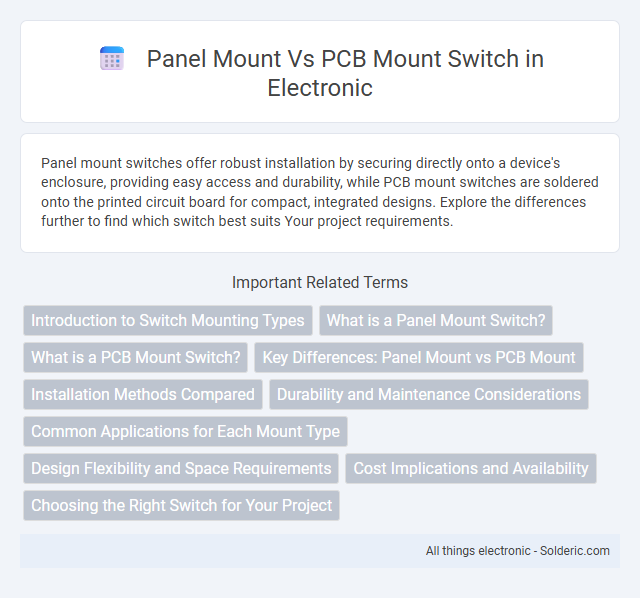Panel mount switches offer robust installation by securing directly onto a device's enclosure, providing easy access and durability, while PCB mount switches are soldered onto the printed circuit board for compact, integrated designs. Explore the differences further to find which switch best suits Your project requirements.
Comparison Table
| Feature | Panel Mount Switch | PCB Mount Switch |
|---|---|---|
| Mounting Location | Mounted on control panels or enclosures | Mounted directly on printed circuit boards (PCBs) |
| Installation | Requires drilling holes in panel for housing and fixing | Soldered onto PCB pads and holes |
| Application | User interface or external controls | Internal circuit switching |
| Size | Generally larger for easy access and operation | Compact for space-saving on PCB |
| Durability | Designed for frequent manual operation and environmental exposure | Designed for internal use with less exposure |
| Wiring | Wired via terminals or connectors | Direct solder connections to PCB traces |
| Common Types | Toggle, rotary, push-button | Tactile, slide, DIP switches |
| Cost | Generally higher due to larger size and rugged design | Lower cost, optimized for volume PCB assembly |
Introduction to Switch Mounting Types
Panel mount switches are installed directly onto an enclosure or panel, providing easy accessibility and robust mechanical stability for user interfaces in industrial and consumer electronics. PCB mount switches attach directly to the printed circuit board, allowing compact, automated assembly processes and reliable electrical connections within the device. Selection between panel mount and PCB mount switches depends on factors like application environment, space constraints, and ease of maintenance.
What is a Panel Mount Switch?
A panel mount switch is designed to be installed directly onto the front panel of a device or enclosure, providing easy access and robust mechanical support. It typically features threaded bushing and a secure fastening mechanism, ensuring stability and durability in various applications such as industrial controls and consumer electronics. You can choose panel mount switches for environments where accessibility and reliable user interaction are critical.
What is a PCB Mount Switch?
A PCB mount switch is designed to be directly soldered onto a printed circuit board (PCB), providing a compact and reliable electrical connection ideal for compact electronic devices. These switches are engineered for easy integration into automated assembly processes, supporting high-density circuit layouts and ensuring consistent performance under various environmental conditions. Unlike panel mount switches, PCB mount switches eliminate the need for additional hardware, enhancing durability and reducing assembly time.
Key Differences: Panel Mount vs PCB Mount
Panel mount switches are installed directly onto the device enclosure, providing robust mechanical support and easier user access, while PCB mount switches are soldered onto the printed circuit board, enabling compact design and automated assembly. Key differences include mounting location, with panel mounts offering external accessibility and enhanced durability, whereas PCB mounts are suited for internal circuit integration and space-saving layouts. Load capacity and sealing options also vary, as panel mount switches often support higher current and better environmental protection compared to typical PCB mount variants.
Installation Methods Compared
Panel mount switches are installed by securing the switch directly onto a panel or enclosure, typically using nuts or screws, providing easy accessibility and clean integration with the device exterior. PCB mount switches are soldered onto a printed circuit board, ensuring a compact design and reliable electrical connections ideal for internal components. Your choice depends on whether external user interface access or internal circuit integration is the priority.
Durability and Maintenance Considerations
Panel mount switches typically offer higher durability due to their robust housing and secure installation, making them ideal for environments subject to frequent mechanical stress. PCB mount switches, while compact and suitable for circuit board integration, may be more susceptible to wear and damage over time, requiring careful handling during maintenance. Maintenance of panel mount switches is generally easier because they can be accessed and replaced without disturbing the PCB, reducing downtime and repair complexity.
Common Applications for Each Mount Type
Panel mount switches are commonly used in industrial control systems, automotive dashboards, and household appliances where easy access and durability are essential. PCB mount switches are typically found in electronic devices like computers, telecommunications equipment, and consumer gadgets where compact size and integration with circuit boards are prioritized. Your choice depends on whether you need surface accessibility or streamlined internal circuitry integration.
Design Flexibility and Space Requirements
Panel mount switches offer greater design flexibility by allowing placement on external surfaces, ideal for user interfaces requiring easy access and customization. PCB mount switches optimize space within electronic devices by being soldered directly onto the circuit board, reducing overall device size and streamlining internal layouts. Choosing the right switch depends on your need for compact integration versus accessible control panel design.
Cost Implications and Availability
Panel mount switches typically incur higher costs due to robust housings and enhanced durability required for external installation, while PCB mount switches are generally more cost-effective because of simplified integration and mass production suitability. Availability of panel mount switches can be limited by specific design requirements and size constraints, whereas PCB mount switches offer a wider variety and easier sourcing through electronic component distributors. Manufacturers often favor PCB mount switches in high-volume applications to optimize cost-efficiency and streamline assembly processes.
Choosing the Right Switch for Your Project
Choosing the right switch for your project depends heavily on the mounting method and application requirements. Panel mount switches offer robust durability and easy access, making them ideal for user interfaces exposed to frequent operation or harsh environments. PCB mount switches provide compact integration and streamlined assembly on circuit boards, perfect for space-constrained electronic devices requiring precise control.
panel mount vs PCB mount switch Infographic

 solderic.com
solderic.com